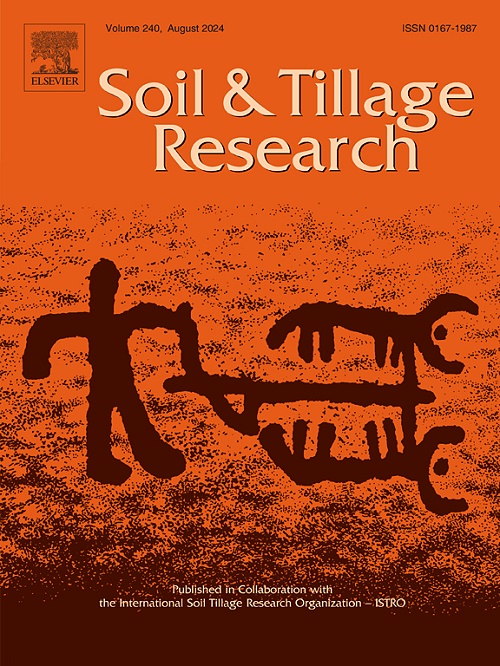Experimental study on dynamic stress and deformation characteristics of landslide dam materials under rolling dynamic compaction
IF 6.1
1区 农林科学
Q1 SOIL SCIENCE
引用次数: 0
Abstract
The frequent occurrence of geological disasters has led to a constant production of landslide dam materials worldwide, which exhibit characteristics such as loose structure, high porosity, and wide gradation, limiting their development and utilization. To investigate the dynamic stress and deformation characteristics of landslide dam materials under rolling dynamic pressure, laboratory rolling dynamic compaction (RDC) model tests were conducted to study the effects of towing speed, impact roller mass, and pass count on dynamic stress propagation, surface settlement, and particle displacement. The results indicate that dynamic stress increases with the number of passes, stabilizing after 12 passes, with significant attenuation at depths above 200 mm. Maximum displacement occurs when the smooth arc surface of the impact roller contacts the foundation, with higher towing speeds facilitating energy transfer to deeper layers and heavier impact rollers enhancing surface compaction. Surface settlement analysis indicates that most cumulative settlement occurs within the first seven passes. PIV analysis reveals significant particle movement during RDC, with the most notable displacement occurring at high towing speeds and impact roller masses. Increasing the towing speed effectively enhances the dynamic stress, facilitating energy transfer to deeper layers, although the influence width remains limited. Enhancing the mass of the impact roller promotes energy transfer horizontally on both sides, improving surface reinforcement, although the depth of influence is similarly restricted. The study concludes that optimizing towing speeds and impact roller masses is crucial for effective compaction and reinforcement, providing a theoretical basis for the design of RDC for landslide dam foundations.
求助全文
约1分钟内获得全文
求助全文
来源期刊

Soil & Tillage Research
农林科学-土壤科学
CiteScore
13.00
自引率
6.20%
发文量
266
审稿时长
5 months
期刊介绍:
Soil & Tillage Research examines the physical, chemical and biological changes in the soil caused by tillage and field traffic. Manuscripts will be considered on aspects of soil science, physics, technology, mechanization and applied engineering for a sustainable balance among productivity, environmental quality and profitability. The following are examples of suitable topics within the scope of the journal of Soil and Tillage Research:
The agricultural and biosystems engineering associated with tillage (including no-tillage, reduced-tillage and direct drilling), irrigation and drainage, crops and crop rotations, fertilization, rehabilitation of mine spoils and processes used to modify soils. Soil change effects on establishment and yield of crops, growth of plants and roots, structure and erosion of soil, cycling of carbon and nutrients, greenhouse gas emissions, leaching, runoff and other processes that affect environmental quality. Characterization or modeling of tillage and field traffic responses, soil, climate, or topographic effects, soil deformation processes, tillage tools, traction devices, energy requirements, economics, surface and subsurface water quality effects, tillage effects on weed, pest and disease control, and their interactions.
 求助内容:
求助内容: 应助结果提醒方式:
应助结果提醒方式:


